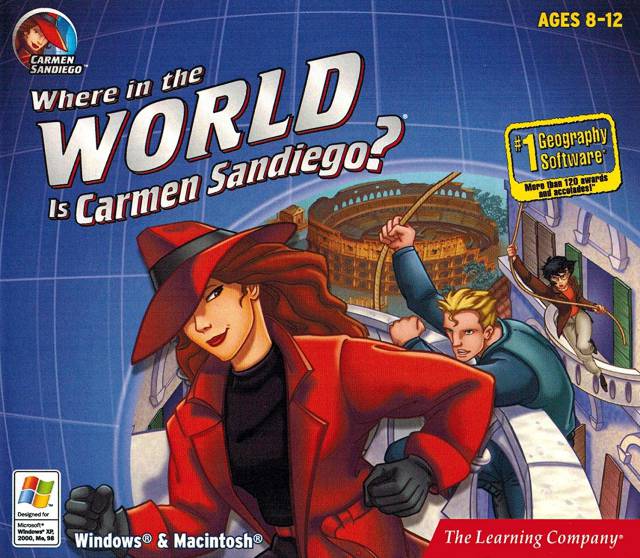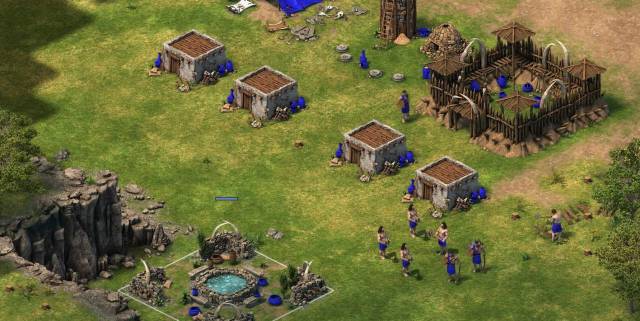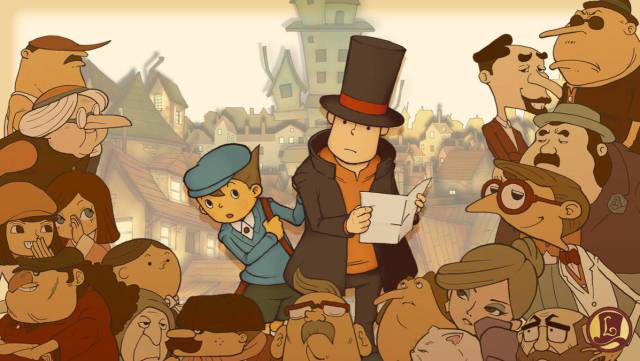
Video games and teaching have gone hand in hand since the beginning of the industry. Today we review educational titles from yesterday and today.
Dignifying the video game as more than one means of entertainment is one of the cultural crusades of the 21st century. At a time when they have been demonized by the mainstream media for their violence and negative effects, the need for information arises that highlights the other side of the coin: the social responsibility of video games as much more than virtual toys. Education is not at odds with fun, and digital entertainment has proven to have value beyond play. We currently have titles that raise awareness about mental illness within an epic adventure, like Hellblade; o Celeste as a tool against anxiety. The video game as a pedagogical tool is nothing new: the arrival of computers in the domestic sphere during the 1980s led to edutainment (education + entertainment): the tendency to create family titles with an instructional purpose, so that parents could contemplate the technology from a benevolent perspective, and the little ones could enrich themselves culturally while enjoying the game.
The term edutainment was coined by Walt Disney in 1954 for the promotion of True-Life Adventures, a series of documentaries produced by the company for educational purposes. In digital entertainment, Boston Phoenix defined edutainment as a new perspective after the end of growth of the Atari 2600: “Mattel Intelvision III: Destined to sweep stores during the Christmas campaign, this is the home video game machine that even the People who want a computer for educational reasons will end up using it mainly to play games ”.
Geography and history with Carmen Sandiego
Carmen Sandiego was one of the heroines that was erected in a time when the mission of video games was to educate while entertaining. This mockery of white glove and scarlet outfit, who mocked authorities around the planet while taking away the most precious works of art, became one of the greatest icons in video game history and one of the most charismatic villains. His debut was in 1985 through Where in the World is Carmen Sandiego ?, designed by Broderbund. The studio – made up of Lauren Elliott, Gene Portwood and Dane Bingham – was inspired by the cop and thief kid's game, Kotaku was told in a report on the game's creative process. With a more refined idea, they achieved a game system and a sense of humor that became a hallmark of what would be a long-running saga. As detectives, we went in search and capture of VILE, the band led by Carmen. In the robbery scene, we collected clues to the thief's whereabouts that tested our geographic knowledge: indications on the flag or monuments about the destination country. Broderbund hired David Siefkin as a screenwriter, for which he steeped himself in universal culture. “Before writing the script for the game, I traveled the world for nine months. I learned many things, such as the different currencies of each country, languages, customs and their most distinctive characteristics. I wanted to introduce all of this cultural value to younger players, hoping to inspire them to travel. ”
Carmen Sandiego, in addition, transcended the video entertainment medium: she had her own children's television contest – which had its Spanish version -, in addition to novels, comics and animation series, including the recent adaptation on Netflix.
 Cover of Where in the World is Carmen Sandiego
Cover of Where in the World is Carmen Sandiego
Reading and history with tenderness and rawness
The crimson thief was not the only educational heroine in the 1980s: at the dawn of video game history, many children learned to read with Reading Rabbit, known in Spain as the Reading Rabbit. Created by the Grimm sisters (Leslie, Corinne and Cindy) and developed by The Learning Company, this point & click with cute animals invited the player to solve with very simple spelling and grammar tests. Its success led to it being cited by the Washington Post as one of the most popular educational titles. In 1999, the saga incorporated the ADAPT system, where player learning was personalized through five characteristics: assessment of skills, development skills, adjustment of levels, assistance, and progress recording.
If we look at early educational titles, we can't leave out The Oregon Trail (1971), created by Don Rawitsch, Paul Dillenberg, and Bill Dillenberger, and later produced by the Minnesota Computer Education Consortium. Through this conversational strategy adventure, students learned about the lives of pioneers on the Oregon Trail in the 19th century. As leaders of a caravan, we had to learn to manage our resources and make decisions such as going hunting or dealing with inclement weather. Also, The Oregon Tail was not at all a candid title: it posed death as a common outcome: "Dying of dysentery made us check what we learned in class," recalls Cedar Coleman, a technician interviewed in Marketplace during a report. about this peculiar title. "Many of us were unable to complete the journey, as we ended up getting sick or starving, victims of a very harsh winter."
 Image from The Oregon Trail, where it is announced that one of our colleagues has dysentery.
Image from The Oregon Trail, where it is announced that one of our colleagues has dysentery.
Like The Oregon Trail, there are educational titles that show that learning for the little ones is not at odds with the harshness. An example of this is The Typing Of The Dead, an adaptation of The House of the Dead (Sega) where we faced hordes of zombies while learning typing: to kill our enemies, we had to write the words that appeared on the screen in the shortest possible time and without misspellings.
The management of empires and cities
Age of Empires and Civilization are titles with great educational value, where the teachings pass in a subtle way and well integrated into the game, without explicitly indicating to the user that they are learning a history lesson. In both titles, we put ourselves in the shoes of an emperor and learn to manage an empire, defend it and expand it, although the political and R&D notions are simplified in favor of pleasant mechanics. In the academic essay Learning Through Play: Benefis From Age Of Empires, Timothy Johnson discusses how the title of Ensemble Studios can bring history closer to students. Aware of the multiple creative licenses that the saga takes, it also highlights its virtues: although in reality the epoch changes are gradual, unlike the almost instantaneous jump that the game allows us, and despite certain anachronisms in the units military, the player knows different historical facts roughly: "The players discover and receive information about historical events, such as the colonization of Ionia by the Athenians, the sacking of Troy, the Peloponnesian War, the march of Xenophon by Persia and the conquests of Alexander the Great. While these episodes are not explored in depth, the basic facts are explained. ”
Also, players receive basic notions about other areas, such as technology or economics: players discover ancient technologies and their impact on a civilization, and they also learn a valuable lesson, as Johnson describes it: “while technology brings its advantages , no technology or unit guarantees victory; it must be used wisely, or we will not obtain great benefits ”.
 Image from Age of Empires: Definitive Edition
Image from Age of Empires: Definitive Edition
For its part, the doctoral thesis Learning World History Through Playing Civilization III (Kurt Squire), analyzes the results of incorporating Civilization III in classrooms. In this work, it is valued how to adapt the game beyond making the students play in class and recommends being aware of "that educational video games are generally developed and marketed with the priority of turning them into entertainment products, with which its use in the classroom is secondary. ” In the Common Sense Education portal, based on the aforementioned thesis, it is recommended to express the cooperative nature of the game, while preparing various lessons oriented to the randomness of events in the game, whether the players decide to engage in war games or progress peacefully. In the educational field, other voices have spoken about the benefits of Civilization, such as Casey Harelson, former director of Kaplan University and a great fan of said strategic title who gave his statements for EdSurge: “Civilization is not going to help Students pass a history or social science exam. However, it encourages players to think with a more intellectual perspective than titles like League of Legends or Call of Duty. At the end of the day, it is a game in which we must make macroscopic societal decisions that affect the composition of our nation. ”
With a more urbanistic perspective, SimCity is analyzed by the Sustainability Improves Student Learning association as a title that “motivates students to participate in systematic changes that result in a more sustainable future, in the sense of social changes and not just personal ones”. In her list of benefits, she cites how students can build effective coalitions and engage in focused dialogues to seek effective decisions, as well as being a game that catalyzes collective action. Likewise, it is a title that develops the creative vision around urban planning and awareness to the student on topics such as climate change, consumption, personal and professional ethics or natural resource management, among others.
 SimCity Art
SimCity Art
Nintendo and education for all
Today we continue to enjoy educational titles that teach us that learning does not have to be limited to textbooks and explanations supported by a whiteboard or Power Point presentation. Thus, Nintendo DS opened a new educational window for young and old with Brain Training, a saga that has been extended to the current Nintendo Switch. This title consists of a set of memory and mathematical mini-games designed to improve mental agility. With the advice of neurologist Ryuta Kawashima, the goal is to exercise the mind while fighting against aging of the brain. On the occasion of the most recent installment of the saga, the doctor stated on the official website of Nintendo the reason for this return: “During my seminars, people who played Brain Training on Nintendo DS ask me: 'And now what game However? It saddens me to discover that interest in the game is written in the past. And when I ask them more about it I find out that these people, who used to play with their children, begin to reach that age when you forget things. The important thing is continuity, something that games in general must deal with, and not just Brain Training. Isn't there a lot of games you play once and then quit? As a specialist in this field, I want players to exercise their brains for long periods of time. ”
Also, Nintendo DS introduced us to a new hero in educational video games who has become the digital equivalent of youth detective literature: Professor Layton. This exquisitely mannered English archaeologist and knight solves mysteries, accompanied by his apprentice Luke. Together they live various adventures designed around puzzles that stimulate the solving capacity of all audiences. Common Sense Education recommends this title in classrooms for its literary value and its puzzles, although teachers are able to overcome the difficulties of introducing several portable consoles in class: “Although it is a long experience, students are They will expose to many activities related to mathematics and language. The hint system and solid progress make it easy for the student to solve problems with very little help. Teachers will be able to ask comprehension questions at the end of each chapter to make sure that students are reading the text in-game, instead of skipping it to get to the next part ”.
Of course, there are many titles in which we can enrich ourselves at an intellectual and / or cultural level and, although in this report there are not all who are, but all who are. All in all, an educational video game is the perfect plan to share alone and with the family, while feeding the brain in a different way than textbooks offer.
 Art of Professor Layton and the Mysterious Villa
Art of Professor Layton and the Mysterious Villa

